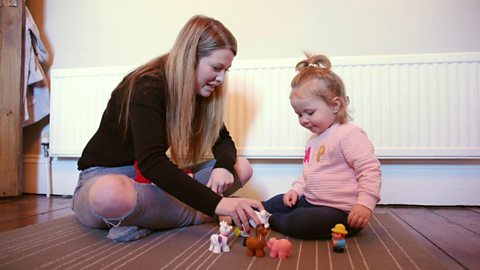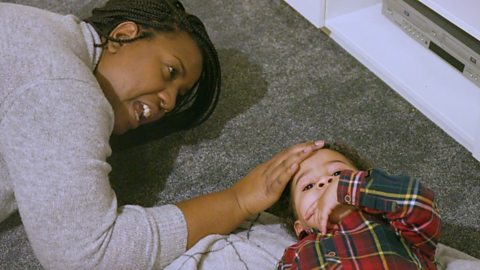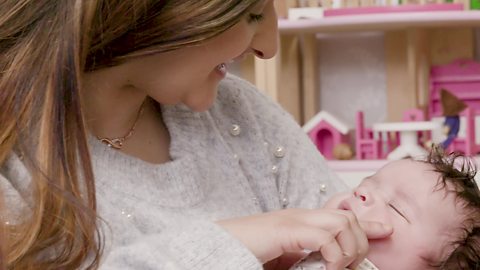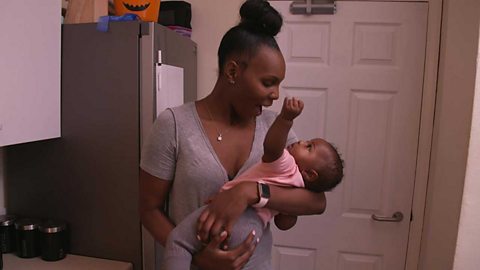How many nursery rhymes do you know by heart? Chances are the lyrics of at least one is etched into your memoryβ¦ probably more if youβve been to a baby class recently!
Some of our favourite rhymes date as far back as the 17th century, and a lot of the lyrics are still the same as they were back then.
So why are these nursery rhymes so popular? And why should we still sing them to our children?
We chatted to Clare Wood, Professor of Psychology at Nottingham Trent University, and a Trustee of the National Literacy Trust, to get some answers.
1. They introduce kids to new words
βNursery rhymes introduce children to new words and ideas that they might not encounter elsewhere at this stage of their development,β says Clare.
Your child usually picks up language from the world around them, so singing nursery rhymes is a great way to introduce words they might not hear during an ordinary day.
Singing Old Macdonald together can be a great way to introduce animal vocabulary. Or you can use One banana, two banana to repeat new food words.
βVocabulary development not only helps children on their journey to understanding and using spoken language, but it is also the foundation for later emerging reading skills.β
2. They help children recognise the sounds in words
As children approach pre-school age, they'll begin to build their understanding of the different sounds that make up words and spot similarities and differences between them.
βThe rhymes and repetition of sounds in nursery rhymes help children to understand this phonological awareness,β Clare explains. βAnd this is an important skill for them to have before they start school.β
Try singing Hickory Dickory Dock with your little one and asking them to find a word that rhymes with the number in each verse.
Dr Michelle Peter discusses the benefits of singing rhymes with families

3. They teach toddlers where words begin and end in sentences
When babies are learning a language, they are not only learning words. Before they can begin processing meaning, they must first listen to what we say and work out where one word ends and the next begins.
βIt has been suggested that children are born with a sensitivity to rhythm in speech,β Clare says. βThis helps them to work out where words begin during normal speech.β
Because nursery rhymes exaggerate and repeat predictable rhythms, they can support childrenβs ability to spot word boundaries in speech and can improve this sensitivity to speech rhythm and boost childrenβs language development.
Rhymes like Sleeping Bunnies or Mary Had A Little Lamb, which can be easily slowed down and sped up, are great for helping with this rhythmic awareness.
4. They boost fine and gross motor skills
From learning how to kick their legs as a newborn to sitting up, crawling and eventually walking, your baby is constantly testing the boundaries of their movement.
Singing nursery rhymes with actions is a great way for babies to develop their motor skills and hand-eye coordination.
Lay your newborn on their back and help their arms do the movements in rhymes like Wheels on the Bus or Wind the Bobbin Up. This can help their body learn and practise movements that they will soon perform by themselves.
These are also great for them to try on their own as they get older. Developing coordination when theyβre young will help with other life skills when theyβre older, such as getting dressed and playing sports.

5. Theyβre great for developing other life skills
βSome nursery rhymes teach basic maths concepts, such as counting and geometry,β explains Clare. βThese are really important early numeracy skills.β
One, Two, Three, Four, Five, Once I Caught a Fish Alive and Six Fat Sausages are great rhymes for all ages, but can especially help pre-school children get to grips with simple maths concepts.
Making up rhymes around an everyday routine, such as bath time or a nappy change, can also help your child understand the steps behind these events and help them process them.
6. They build emotional awareness
Childrenβs emotional development begins long before they can tell us how theyβre feeling. They only really start developing the ability to express their emotions in words between three and five.
But nursery rhymes can play an important role in introducing babies and toddlers to emotions and vocabulary around them.
If youβre happy and you know it contains lots of key emotions for your child. Exaggerating your facial expressions and gestures whilst singing can also help improve their understanding.

7. They strengthen the bond between you and your child
βWhen you are sharing songs and rhymes these are special moments,β says Clare.
Singing rhymes regularly with them while you cuddle them is a great way to bond. This then increases the production of a hormone called oxytocin in the brain.
Oxytocin is known as the love hormone as it reduces stress and increases relaxation, so it's great for you and your baby.
When you and your child are connecting through laughter and shared experience, what could be better?






